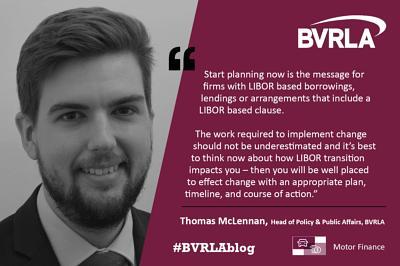Thomas McLennan, BVRLA’s Head of Policy & Public Affairs provides an insight into the upcoming LIBOR transition.

LIBOR (London Interbank Offer Rate) quotes will disappear after 2021 and current LIBOR based arrangements extending into 2022, will need to be updated to remain effective.
Start planning now is the message for firms with LIBOR based borrowings, lendings or arrangements that include a LIBOR based clause.
This is because LIBOR quotes will no longer be available after 2021 and relevant clauses will need to be updated. Without transition to a new rate, clauses will not operate as originally intended - action therefore needs to be taken in 2021 to ensure that this does not happen.
In addition to LIBOR linked loans and borrowings, other less obvious areas will be impacted e.g. interest on late payment clauses, calculation of sums due on terminations of arrangements – LIBOR can appear in all sorts of unexpected places!
The LIBOR transition is part of the UK regulators’ reform of benchmark interest rates. It is also part of global activity to reform global benchmark rates. Hence, you could be affected by changes outside the UK if you have arrangements that include other benchmark quotes.
Reform follows the post financial crisis review of benchmark rates where cases of attempted market manipulation of some interest rate benchmarks were discovered.
UK regulators recognise that time is now short and are keen for businesses to update contracts with replacement rates, as soon as possible. Inevitably discussions to a agree a suitable alternative will require time, patience, and resource - external (e.g. legal) input might be required and therefore it is likely that there will be cost to the change.
LIBOR replacements might include, for example, moving to the Bank of England’s base rate or a fixed rate. There is also SONIA (Sterling Overnight Index Average). SONIA is based on actual transactions and reflects the average of the interest rates that banks pay to borrow sterling overnight from other financial institutions and other institutional investors. SONIA, however, will not necessarily be the same as LIBOR, the latter might include bank term credit risk as well as a liquidity premium and therefore a credit spread adjustment (CSA) will be required to compensate for the difference.
The Bank of England publishes a daily SONIA Compounded Index whilst the CSA will likely have to be negotiated.
The rate to which you transition, should be the appropriate rate for you.
The work required to implement change should not be underestimated and it’s best to think now about how LIBOR transition impacts you – then you will be well placed to effect change with an appropriate plan, timeline, and course of action.





